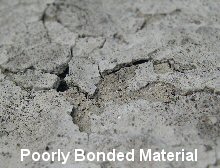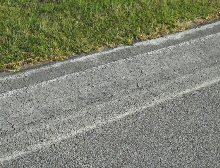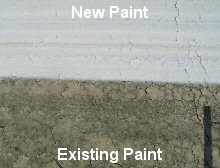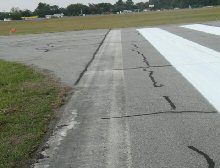
|

|
|
Runway Pavements Host to CyanobacteriaBy Donna Speidel
Since then, we have encountered a few other airports plagued by the pesky and tenacious bacteria that live in water or wet environments and can manufacture their own food. They have the distinction of being the oldest known fossils, more than 3.5 billion years old! So the likelihood of us lowly humans defeating them is slim; but we can at least clean them off runway markings before we put more paint down.
What we have encountered on airfield pavements are large colonies of algae, usually dormant, that have grown over the pavement, including the markings. The markings become so obscured by the algae that they disappear. Unaware of the slimy coating, airfield marking contractors and crews routinely apply a fresh coat of paint to the pavement surface, making it look better, but only for a little while. The result is a poor bond of the new paint coating to the underlying layers of paint, which are separated by a healthy coating of cyanobacteria or blue-green algae. The new paint begins to peel with the slightest provocation; and another cycle of loose and poorly bonded paint is perpetuated.
The remedy is to waterblast the markings to clean away the algae coating, thus exposing a surface more likely to bond with the newly applied paint. Unfortunately for the airports, using their fire trucks (at 150 psi) to blast the stubborn bacterial growth from the markings is ineffective. This airport tried that method, not wanting to pay the price of the waterblasting. As you can see, all they did was waste their time and water; and then still paid the contractor to paint right over the blackish surface. Within a few months, the new paint will appear just as old and dingy as the existing, only now they'll have peeling paint too.
The before and after shots above of the algae-covered aiming point marking are from an airport that saw the merits
of properly cleaning the surface, in spite of having to pay over 20 cents per square foot for cleaning. In the process of cleaning the algae,
the contractor also removed all the loose, scaling paint that had accumulated from repeated repaints over algae and loose paint. The
benefits to cleaning will be that the markings will not have to be repainted for at least three years or more. And this very special airport is
the proud guinea pig for our collaborative efforts in a biocide treated paint that should resist the algae growth. Time will tell...
|

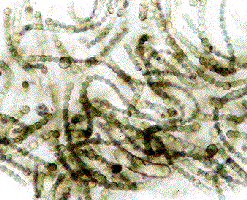 In our "What's New" column from our
In our "What's New" column from our  When an algae covered surface gets wet, it gets slippery, because the organisms are actively making food and
multiplying (in bloom), sometimes doubling their population within hours. When that surface dries out, the algae become dormant,
forming a protective sheath or covering over the organism. On pavement, a colony of dormant algae appears black. If that pavement
happens to be on an airfield where markings are painted, the algae resolutely continue their steady march as soon as wet conditions return
and they resume their feeding and growth cycles.
When an algae covered surface gets wet, it gets slippery, because the organisms are actively making food and
multiplying (in bloom), sometimes doubling their population within hours. When that surface dries out, the algae become dormant,
forming a protective sheath or covering over the organism. On pavement, a colony of dormant algae appears black. If that pavement
happens to be on an airfield where markings are painted, the algae resolutely continue their steady march as soon as wet conditions return
and they resume their feeding and growth cycles.
